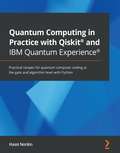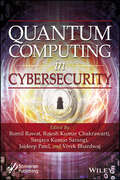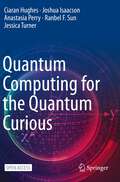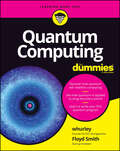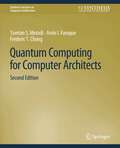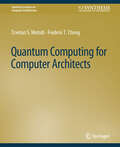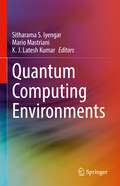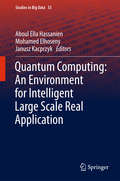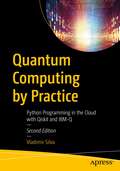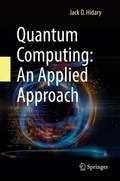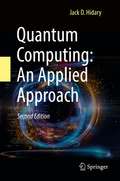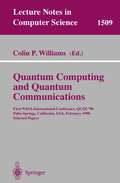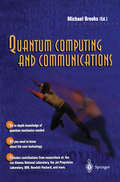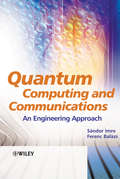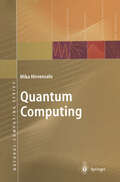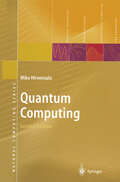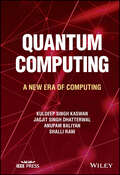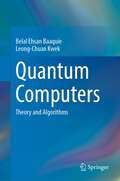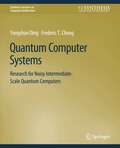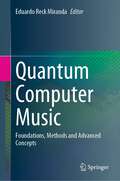- Table View
- List View
Quantum Computing in Practice with Qiskit® and IBM Quantum Experience®: Practical recipes for quantum computer coding at the gate and algorithm level with Python
by Hassi NorlenUnderstand the nuances of programming traditional quantum computers and solve the challenges of the future while building and executing quantum programs on IBM Quantum hardware and simulatorsKey FeaturesWork your way up from writing a simple quantum program to programming complex quantum algorithmsExplore the probabilistic nature of qubits by performing quantum coin tosses and using random number generatorsDelve into quantum algorithms and their practical applications in various domainsBook DescriptionIBM Quantum Experience® is a leading platform for programming quantum computers and implementing quantum solutions directly on the cloud. This book will help you get up to speed with programming quantum computers and provide solutions to the most common problems and challenges.You'll start with a high-level overview of IBM Quantum Experience® and Qiskit®, where you will perform the installation while writing some basic quantum programs. This introduction puts less emphasis on the theoretical framework and more emphasis on recent developments such as Shor's algorithm and Grover's algorithm. Next, you'll delve into Qiskit®, a quantum information science toolkit, and its constituent packages such as Terra, Aer, Ignis, and Aqua. You'll cover these packages in detail, exploring their benefits and use cases. Later, you'll discover various quantum gates that Qiskit® offers and even deconstruct a quantum program with their help, before going on to compare Noisy Intermediate-Scale Quantum (NISQ) and Universal Fault-Tolerant quantum computing using simulators and actual hardware. Finally, you'll explore quantum algorithms and understand how they differ from classical algorithms, along with learning how to use pre-packaged algorithms in Qiskit® Aqua.By the end of this quantum computing book, you'll be able to build and execute your own quantum programs using IBM Quantum Experience® and Qiskit® with Python.What you will learnVisualize a qubit in Python and understand the concept of superpositionInstall a local Qiskit® simulator and connect to actual quantum hardwareCompose quantum programs at the level of circuits using Qiskit® TerraCompare and contrast Noisy Intermediate-Scale Quantum computing (NISQ) and Universal Fault-Tolerant quantum computing using simulators and IBM Quantum® hardwareMitigate noise in quantum circuits and systems using Qiskit® IgnisUnderstand the difference between classical and quantum algorithms by implementing Grover's algorithm in Qiskit®Who this book is forThis book is for developers, data scientists, machine learning researchers, or quantum computing enthusiasts who want to understand how to use IBM Quantum Experience® and Qiskit® to implement quantum solutions and gain practical quantum computing experience. Python programming experience is a must to grasp the concepts covered in the book more effectively. Basic knowledge of quantum computing will also be beneficial.
Quantum Computing in Cybersecurity
by Romil Rawat Rajesh Kumar Chakrawarti Sanjaya Kumar Sarangi Jaideep Patel Vivek Bhardwaj Anjali Rawat Hitesh RawatMachine learning, deep learning, probabilistic neural networks, blockchain, and other new technologies all demand extremely high processing speeds. A quantum computer is an example of such a system. Quantum computers may be accessed over the internet. This technology poses a significant risk, since quantum terrorists, or cyber criminals, coul be able to cause many problems, including bringing down the internet. The principles of quantum mechanics might be used by evil doers to destroy quantum information on a global scale, and an entire class of suspicious codes could destroy data or eavesdrop on communication. Quantum physics, however, safeguards against data eavesdropping. A significant amount of money is being invested in developing and testing a quantum version of the internet that will eliminate eavesdropping and make communication nearly impenetrable to cyber-attacks. The simultaneous activation of quantum terrorists (organized crime) can lead to significant danger by attackers introducing quantum information into the network, breaking the global quantum state, and preventing the system from returning to its starting state. Without signs of identifying information and real-time communication data, such vulnerabilities are very hard to discover. Terrorists' synchronized and coordinated acts have an impact on security by sparking a cyber assault in a fraction of a second. The encryption is used by cyber-criminal groups with the genuine, nefarious, and terrible motives of killing innocent people or stealing money. In the hands of criminals and codes, cryptography is a dangerous and formidable weapon. Small amounts of digital information are hidden in a code string that translates into an image on the screen, making it impossible for the human eye to identify a coded picture from its uncoded equivalents. To steal the cryptographic key necessary to read people's credit card data or banking information, cyber thieves employ installed encryption techniques, human mistakes, keyboard loggers, and computer malware. This new volume delves into the latest cutting-edge trends and the most up-to-date processes and applications for quantum computing to bolster cybersecurity. Whether for the veteran computer engineer working in the field, other computer scientists and professionals, or for the student, this is a one-stop-shop for quantum computing in cyber security and a must have for any library.
Quantum Computing in Cybersecurity
by Romil Rawat Rajesh Kumar Chakrawarti Sanjaya Kumar Sarangi Jaideep Patel Vivek Bhardwaj Anjali Rawat Hitesh RawatMachine learning, deep learning, probabilistic neural networks, blockchain, and other new technologies all demand extremely high processing speeds. A quantum computer is an example of such a system. Quantum computers may be accessed over the internet. This technology poses a significant risk, since quantum terrorists, or cyber criminals, coul be able to cause many problems, including bringing down the internet. The principles of quantum mechanics might be used by evil doers to destroy quantum information on a global scale, and an entire class of suspicious codes could destroy data or eavesdrop on communication. Quantum physics, however, safeguards against data eavesdropping. A significant amount of money is being invested in developing and testing a quantum version of the internet that will eliminate eavesdropping and make communication nearly impenetrable to cyber-attacks. The simultaneous activation of quantum terrorists (organized crime) can lead to significant danger by attackers introducing quantum information into the network, breaking the global quantum state, and preventing the system from returning to its starting state. Without signs of identifying information and real-time communication data, such vulnerabilities are very hard to discover. Terrorists' synchronized and coordinated acts have an impact on security by sparking a cyber assault in a fraction of a second. The encryption is used by cyber-criminal groups with the genuine, nefarious, and terrible motives of killing innocent people or stealing money. In the hands of criminals and codes, cryptography is a dangerous and formidable weapon. Small amounts of digital information are hidden in a code string that translates into an image on the screen, making it impossible for the human eye to identify a coded picture from its uncoded equivalents. To steal the cryptographic key necessary to read people's credit card data or banking information, cyber thieves employ installed encryption techniques, human mistakes, keyboard loggers, and computer malware. This new volume delves into the latest cutting-edge trends and the most up-to-date processes and applications for quantum computing to bolster cybersecurity. Whether for the veteran computer engineer working in the field, other computer scientists and professionals, or for the student, this is a one-stop-shop for quantum computing in cyber security and a must have for any library.
Quantum Computing for the Quantum Curious
by Jessica Turner Ciaran Hughes Joshua Isaacson Anastasia Perry Ranbel F. SunThis open access book makes quantum computing more accessible than ever before. A fast-growing field at the intersection of physics and computer science, quantum computing promises to have revolutionary capabilities far surpassing “classical” computation. Getting a grip on the science behind the hype can be tough: at its heart lies quantum mechanics, whose enigmatic concepts can be imposing for the novice. This classroom-tested textbook uses simple language, minimal math, and plenty of examples to explain the three key principles behind quantum computers: superposition, quantum measurement, and entanglement. It then goes on to explain how this quantum world opens up a whole new paradigm of computing. The book bridges the gap between popular science articles and advanced textbooks by making key ideas accessible with just high school physics as a prerequisite. Each unit is broken down into sections labelled by difficulty level, allowing the course to be tailored to the student’s experience of math and abstract reasoning. Problem sets and simulation-based labs of various levels reinforce the concepts described in the text and give the reader hands-on experience running quantum programs. This book can thus be used at the high school level after the AP or IB exams, in an extracurricular club, or as an independent project resource to give students a taste of what quantum computing is really about. At the college level, it can be used as a supplementary text to enhance a variety of courses in science and computing, or as a self-study guide for students who want to get ahead. Additionally, readers in business, finance, or industry will find it a quick and useful primer on the science behind computing’s future.
Quantum Computing For Dummies
by William Hurley Floyd Earl SmithComprehend the mysteries—and the amazing potential—of quantum computing Quantum computing has the promise to be the next huge thing in technology. How do we know that? Look at how much the big players in tech are investing in the technology. Quantum Computing For Dummies preps you for the amazing changes that are coming with the world of computing built on the phenomena of quantum mechanics. Need to know what is it and how does it work? This easy-to-understand book breaks it down and answers your most pressing questions. Get a better understanding of how quantum computing is revolutionizing networking, data management, cryptography, and artificial intelligence in ways that would have previously been unthinkable. With a Dummies guide by your side, you’ll get a primer on the inner workings and practical applications of quantum computers. Learn the difference binary and quantum computers Discover which industries will be most influenced by quantum computing See how quantum improves encryption and enables business Take a look at how quantum is applied in big data and AIFor technologists and IT pros interested in getting on board the quantum train—plus anyone who’s quantum-curious—this Dummies guide is a must-have.
Quantum Computing For Dummies
by William Hurley Floyd Earl SmithComprehend the mysteries—and the amazing potential—of quantum computing Quantum computing has the promise to be the next huge thing in technology. How do we know that? Look at how much the big players in tech are investing in the technology. Quantum Computing For Dummies preps you for the amazing changes that are coming with the world of computing built on the phenomena of quantum mechanics. Need to know what is it and how does it work? This easy-to-understand book breaks it down and answers your most pressing questions. Get a better understanding of how quantum computing is revolutionizing networking, data management, cryptography, and artificial intelligence in ways that would have previously been unthinkable. With a Dummies guide by your side, you’ll get a primer on the inner workings and practical applications of quantum computers. Learn the difference binary and quantum computers Discover which industries will be most influenced by quantum computing See how quantum improves encryption and enables business Take a look at how quantum is applied in big data and AIFor technologists and IT pros interested in getting on board the quantum train—plus anyone who’s quantum-curious—this Dummies guide is a must-have.
Quantum Computing for Computer Architects, Second Edition (Synthesis Lectures on Computer Architecture)
by Tzvetan Metodi Arvin I. FaruqueQuantum computers can (in theory) solve certain problems far faster than a classical computer running any known classical algorithm. While existing technologies for building quantum computers are in their infancy, it is not too early to consider their scalability and reliability in the context of the design of large-scale quantum computers. To architect such systems, one must understand what it takes to design and model a balanced, fault-tolerant quantum computer architecture. The goal of this lecture is to provide architectural abstractions for the design of a quantum computer and to explore the systems-level challenges in achieving scalable, fault-tolerant quantum computation. In this lecture, we provide an engineering-oriented introduction to quantum computation with an overview of the theory behind key quantum algorithms. Next, we look at architectural case studies based upon experimental data and future projections for quantum computation implemented using trapped ions. While we focus here on architectures targeted for realization using trapped ions, the techniques for quantum computer architecture design, quantum fault-tolerance, and compilation described in this lecture are applicable to many other physical technologies that may be viable candidates for building a large-scale quantum computing system. We also discuss general issues involved with programming a quantum computer as well as a discussion of work on quantum architectures based on quantum teleportation. Finally, we consider some of the open issues remaining in the design of quantum computers. Table of Contents: Introduction / Basic Elements for Quantum Computation / Key Quantum Algorithms / Building Reliable and Scalable Quantum Architectures / Simulation of Quantum Computation / Architectural Elements / Case Study: The Quantum Logic Array Architecture / Programming the Quantum Architecture / Using the QLA for Quantum Simulation: The Transverse Ising Model / Teleportation-Based Quantum Architectures / Concluding Remarks
Quantum Computing for Computer Architects (Synthesis Lectures on Computer Architecture)
by Tzvetan S. Metodi Frederic T. ChongQuantum computation may seem to be a topic for science fiction, but small quantum computers have existed for several years and larger machines are on the drawing table. These efforts have been fueled by a tantalizing property: while conventional computers employ a binary representation that allows computational power to scale linearly with resources at best, quantum computations employ quantum phenomena that can interact to allow computational power that is exponential in the number of "quantum bits" in the system. Quantum devices rely on the ability to control and manipulate binary data stored in the phase information of quantum wave functions that describe the electronic states of individual atoms or the polarization states of photons. While existing quantum technologies are in their infancy, we shall see that it is not too early to consider scalability and reliability. In fact, such considerations are a critical link in the development chain of viable device technologies capable of orchestrating reliable control of tens of millions quantum bits in a large-scale system. The goal of this lecture is to provide architectural abstractions common to potential technologies and explore the systemslevel challenges in achieving scalable, fault-tolerant quantum computation. The central premise of the lecture is directed at quantum computation (QC) architectural issues. We stress the fact that the basic tenet of large-scale quantum computing is reliability through system balance: the need to protect and control the quantum information just long enough for the algorithm to complete execution. To architectQCsystems, onemust understand what it takes to design and model a balanced, fault-tolerant quantum architecture just as the concept of balance drives conventional architectural design. For example, the register file depth in classical computers is matched to the number of functional units, the memory bandwidth to the cache miss rate, or the interconnect bandwidth matched to the compute power of each element of a multiprocessor. We provide an engineering-oriented introduction to quantum computation and provide an architectural case study based upon experimental data and future projection for ion-trap technology.We apply the concept of balance to the design of a quantum computer, creating an architecture model that balances both quantum and classical resources in terms of exploitable parallelism in quantum applications. From this framework, we also discuss the many open issues remaining in designing systems to perform quantum computation.
Quantum Computing Environments
by Sitharama S. Iyengar Mario Mastriani K. J. Latesh KumarThis book explains the evolution of techniques and strategies in quantum computing, discussing the digital transition towards the quantum computing application in various sectors. The book provides a comprehensive insight into the quantum mechanics and quantum computing techniques and tools and how they have evolved and the impacted in supporting and flourishing business during the quantum computing era. This book includes chapters that discuss the most primitive quantum schemes to the most recent use of Internet, finance and radar technology, thus leveraging greater use of new technologies like security and Internet and others. The content is relevant for an audience that is involved in the research and development of advanced quantum systems. It gives the industry, researchers, and students interested in learning the various quantum computing sectors with the necessary information and tools that can be used to research, design and develop advanced quantum computing systems and techniques.
Quantum Computing:An Environment for Intelligent Large Scale Real Application (Studies in Big Data #33)
by Aboul Ella Hassanien Mohamed Elhoseny Janusz KacprzykThis book highlights practical quantum key distribution systems and research on the implementations of next-generation quantum communication, as well as photonic quantum device technologies. It discusses how the advances in quantum computing and quantum physics have allowed the building, launching and deploying of space exploration systems that are capable of more and more as they become smaller and lighter. It also presents theoretical and experimental research on the potential and limitations of secure communication and computation with quantum devices, and explores how security can be preserved in the presence of a quantum computer, and how to achieve long-distance quantum communication. The development of a real quantum computer is still in the early stages, but a number of research groups have investigated the theoretical possibilities of such computers.
Quantum Computing by Practice: Python Programming in the Cloud with Qiskit and IBM-Q
by Vladimir SilvaLearn to write algorithms and program in the new field of quantum computing. This second edition is updated to equip you with the latest knowledge and tools needed to be a complex problem-solver in this ever-evolving landscape. The book has expanded its coverage of current and future advancements and investments by IT companies in this emerging technology. Most chapters are thoroughly revised to incorporate the latest updates to IBM Quantum's systems and offerings, such as improved algorithms, integrating hardware advancements, software enhancements, bug fixes, and more. You’ll examine quantum computing in the cloud and run experiments there on a real quantum device. Along the way you’ll cover game theory with the Magic Square, an example of quantum pseudo-telepathy. You’ll also learn to write code using QISKit, Python SDK, and other APIs such as QASM and execute it against simulators (local or remote) or a real quantum computer. Then peek inside the inner workings of the Bell states for entanglement, Grover’s algorithm for linear search, Shor’s algorithm for integer factorization, and other algorithms in the fields of optimization, and more. Finally, you’ll learn the current quantum algorithms for entanglement, random number generation, linear search, integer factorization, and others. By the end of this book, you’ll understand how quantum computing provides massive parallelism and significant computational speedups over classical computersWhat You'll LearnWrite algorithms that provide superior performance over their classical counterpartsCreate a quantum number generator: the quintessential coin flip with a quantum twistExamine the quantum algorithms in use today for random number generation, linear search, and moreDiscover quantum teleportationHandle the counterfeit coin problem, a classic puzzle Put your knowledge to the test with more than 150 practice exercises Who This Book Is ForDevelopers, programmers, computer science researchers, teachers, and students.
Quantum Computing: An Applied Approach
by Jack D. HidaryThis book integrates the foundations of quantum computing with a hands-on coding approach to this emerging field; it is the first work to bring these strands together in an updated manner. This work is suitable for both academic coursework and corporate technical training.This volume comprises three books under one cover: Part I outlines the necessary foundations of quantum computing and quantum circuits. Part II walks through the canon of quantum computing algorithms and provides code on a range of quantum computing methods in current use. Part III covers the mathematical toolkit required to master quantum computing. Additional resources include a table of operators and circuit elements and a companion GitHub site providing code and updates.Jack D. Hidary is a research scientist in quantum computing and in AI at Alphabet X, formerly Google X. “Quantum Computing will change our world in unexpected ways. Everything technology leaders, engineers and graduate students need is in this book including the methods and hands-on code to program on this novel platform.” —Eric Schmidt, PhD, Former Chairman and CEO of Google; Founder, Innovation Endeavors
Quantum Computing: An Applied Approach
by Jack D. HidaryThis book integrates the foundations of quantum computing with a hands-on coding approach to this emerging field; it is the first to bring these elements together in an updated manner. This work is suitable for both academic coursework and corporate technical training.The second edition includes extensive updates and revisions, both to textual content and to the code. Sections have been added on quantum machine learning, quantum error correction, Dirac notation and more. This new edition benefits from the input of the many faculty, students, corporate engineering teams, and independent readers who have used the first edition.This volume comprises three books under one cover: Part I outlines the necessary foundations of quantum computing and quantum circuits. Part II walks through the canon of quantum computing algorithms and provides code on a range of quantum computing methods in current use. Part III covers the mathematical toolkit required to master quantum computing. Additional resources include a table of operators and circuit elements and a companion GitHub site providing code and updates.Jack D. Hidary is a research scientist in quantum computing and in AI at Alphabet X, formerly Google X.
Quantum Computing and Quantum Communications: First NASA International Conference, QCQC '98, Palm Springs, California, USA, February 17-20, 1998, Selected Papers (Lecture Notes in Computer Science #1509)
by Colin P. WilliamsQuantum Computing and Communications
by Michael BrooksThe first handbook to provide a comprehensive inter-disciplinary overview of QCC. It includes peer-reviewed definitions of key terms such as Quantum Logic Gates, Error Correction, Quantum Dots, Nuclear Magnetic Resonance, Quantum Holography, and Quantum Cryptography. There are also reports on major application areas, principles of QCC, and targets, benchmarks and challenges, making this an invaluable buy for any university department with this exciting new topic in its curriculum. It equally provides a unique overview of a fast-moving and multidisciplinary topic for researchers, students, lecturers, and even the interested amateur.
Quantum Computing and Communications: An Engineering Approach
by Sandor Imre Ferenc BalazsQuantum computers will revolutionize the way telecommunications networks function. Quantum computing holds the promise of solving problems that would be intractable with conventional computers by implementing principles from quantum physics in the development of computer hardware, software and communications equipment. Quantum-assisted computing will be the first step towards full quantum systems, and will cause immense disruption of our traditional networks. The world’s biggest manufacturers are investing large amounts of resources to develop crucial quantum-assisted circuits and devices. Quantum Computing and Communications: Gives an overview of basic quantum computing algorithms and their enhanced versions such as efficient database searching, counting and phase estimation. Introduces quantum-assisted solutions for telecom problems including multi-user detection in mobile systems, routing in IP based networks, and secure ciphering key distribution. Includes an accompanying website featuring exercises (with solution manual) and sample algorithms from the classical telecom world, corresponding quantum-based solutions, bridging the gap between pure theory and engineering practice. This book provides telecommunications engineers, as well as graduate students and researchers in the fields of computer science and telecommunications, with a wide overview of quantum computing & communications and a wealth of essential, practical information.
Quantum Computing and Communications: An Engineering Approach
by Sandor Imre Ferenc BalazsQuantum computers will revolutionize the way telecommunications networks function. Quantum computing holds the promise of solving problems that would be intractable with conventional computers by implementing principles from quantum physics in the development of computer hardware, software and communications equipment. Quantum-assisted computing will be the first step towards full quantum systems, and will cause immense disruption of our traditional networks. The world’s biggest manufacturers are investing large amounts of resources to develop crucial quantum-assisted circuits and devices. Quantum Computing and Communications: Gives an overview of basic quantum computing algorithms and their enhanced versions such as efficient database searching, counting and phase estimation. Introduces quantum-assisted solutions for telecom problems including multi-user detection in mobile systems, routing in IP based networks, and secure ciphering key distribution. Includes an accompanying website featuring exercises (with solution manual) and sample algorithms from the classical telecom world, corresponding quantum-based solutions, bridging the gap between pure theory and engineering practice. This book provides telecommunications engineers, as well as graduate students and researchers in the fields of computer science and telecommunications, with a wide overview of quantum computing & communications and a wealth of essential, practical information.
Quantum Computing Algorithms: Discover how a little math goes a long way
by Barry BurdExplore essential quantum computing algorithms and master concepts intuitively with minimal math expertise requiredKey FeaturesLearn the fundamentals with an introduction to matrix arithmeticWrite quantum computing programs in Qiskit—IBM’s publicly available quantum computing websiteEmail your questions directly to the author—no question is too elementaryPurchase of the print or Kindle book includes a free PDF eBookBook DescriptionNavigate the quantum computing spectrum with this book, bridging the gap between abstract, math-heavy texts and math-avoidant beginner guides. Unlike intermediate-level books that often leave gaps in comprehension, this all-encompassing guide offers the missing links you need to truly understand the subject. Balancing intuition and rigor, this book empowers you to become a master of quantum algorithms. No longer confined to canned examples, you'll acquire the skills necessary to craft your own quantum code. Quantum Computing Algorithms is organized into four sections to build your expertise progressively. The first section lays the foundation with essential quantum concepts, ensuring that you grasp qubits, their representation, and their transformations. Moving to quantum algorithms, the second section focuses on pivotal algorithms — specifically, quantum key distribution and teleportation. The third section demonstrates the transformative power of algorithms that outpace classical computation and makes way for the fourth section, helping you to expand your horizons by exploring alternative quantum computing models. By the end of this book, quantum algorithms will cease to be mystifying as you make this knowledge your asset and enter a new era of computation, where you have the power to shape the code of reality.What you will learnDefine quantum circuitsHarness superposition and entanglement to solve classical problemsGain insights into the implementation of quantum teleportationExplore the impact of quantum computing on cryptographyTranslate theoretical knowledge into practical skills by writing and executing code on real quantum hardwareExpand your understanding of this domain by uncovering alternative quantum computing modelsWho this book is forThis book is for individuals familiar with algebra and computer programming, eager to delve into modern physics concepts. Whether you've dabbled in introductory quantum computing material or are seeking deeper insights, this quantum computing book is your gateway to in-depth exploration.
Quantum Computing (Natural Computing Series)
by Mika HirvensaloMika Hirvensalo maps out the new multidisciplinary research area of quantum computing. The text contains an introduction to quantum computing as well as the most important recent results on the topic. The presentation is uniform and computer science-oriented. Thus, the book differs from most of the previous ones which are mainly physics-oriented. The special style of presentation makes the theory of quantum computing accessible to a larger audience. Many examples and exercises ease the understanding. In this second edition, a new chapter on quantum information has been added and numerous corrections, amendments, and extensions have been incorporated throughout the entire text.
Quantum Computing (Natural Computing Series)
by Mika HirvensaloMika Hirvensalo maps out the new multidisciplinary research area of quantum computing. The text contains an introduction to quantum computing as well as the most important recent results on the topic. The presentation is uniform and computer science-oriented. Thus, the book differs from most of the previous ones which are mainly physics-oriented. The special style of presentation makes the theory of quantum computing accessible to a larger audience. Many examples and exercises ease the understanding. In this second edition, a new chapter on quantum information has been added and numerous corrections, amendments, and extensions have been incorporated throughout the entire text.
Quantum Computing: A New Era of Computing
by Kuldeep Singh Kaswan Jagjit Singh Dhatterwal Anupam Baliyan Shalli RaniQUANTUM COMPUTING A helpful introduction to all aspects of quantum computing Quantum computing is a field combining quantum mechanics—the physical science of nature at the scale of atoms and subatomic particles—and information science. Where ordinary computing uses bits, logical values whose position can either be 0 or 1, quantum computing is built around qubits, a fundamental unit of quantum information which can exist in a superposition of both states. As quantum computers are able to complete certain kinds of functions more accurately and efficiently than computers built on classical binary logic, quantum computing is an emerging frontier which promises to revolutionize information science and its applications. This book provides a concise, accessible introduction to quantum computing. It begins by introducing the essentials of quantum mechanics that information and computer scientists require, before moving to detailed discussions of quantum computing in theory and practice. As quantum computing becomes an ever-greater part of the global information technology landscape, the knowledge in Quantum Computing will position readers to join a vital and highly marketable field of research and development. The book’s readers will also find: Detailed diagrams and illustrations throughout A broadly applicable quantum algorithm that improves on the best-known classical algorithms for a wide range of problems In-depth discussion of essential topics including key distribution, cluster state quantum computing, superconducting qubits, and more Quantum Computing is perfect for advanced undergraduate and graduate students in computer science, engineering, mathematics, or the physical sciences, as well as for researchers and academics at the intersection of these fields who want a concise reference.
Quantum Computing: A New Era of Computing
by Kuldeep Singh Kaswan Jagjit Singh Dhatterwal Anupam Baliyan Shalli RaniQUANTUM COMPUTING A helpful introduction to all aspects of quantum computing Quantum computing is a field combining quantum mechanics—the physical science of nature at the scale of atoms and subatomic particles—and information science. Where ordinary computing uses bits, logical values whose position can either be 0 or 1, quantum computing is built around qubits, a fundamental unit of quantum information which can exist in a superposition of both states. As quantum computers are able to complete certain kinds of functions more accurately and efficiently than computers built on classical binary logic, quantum computing is an emerging frontier which promises to revolutionize information science and its applications. This book provides a concise, accessible introduction to quantum computing. It begins by introducing the essentials of quantum mechanics that information and computer scientists require, before moving to detailed discussions of quantum computing in theory and practice. As quantum computing becomes an ever-greater part of the global information technology landscape, the knowledge in Quantum Computing will position readers to join a vital and highly marketable field of research and development. The book’s readers will also find: Detailed diagrams and illustrations throughout A broadly applicable quantum algorithm that improves on the best-known classical algorithms for a wide range of problems In-depth discussion of essential topics including key distribution, cluster state quantum computing, superconducting qubits, and more Quantum Computing is perfect for advanced undergraduate and graduate students in computer science, engineering, mathematics, or the physical sciences, as well as for researchers and academics at the intersection of these fields who want a concise reference.
Quantum Computers: Theory and Algorithms
by Belal Ehsan Baaquie Leong-Chuan KwekThis book presents various theories and algorithms to create a quantum computer. The concept of the classical and quantum computers, and the concept of circuits and gates are reviewed. The example of the Deutsch and the Deutsch-Josca algorithm is discussed to illustrate some key features of quantum computing. The Grover algorithm, considered to be of major milestone of the subject, is discussed in detail to exemplify the techniques used in computer algorithms. The role of quantum superposition (also called quantum parallelism) and of quantum entanglement is discussed in order to understand the key advantages of a quantum over a classical computer.
Quantum Computer Systems: Research for Noisy Intermediate-Scale Quantum Computers (Synthesis Lectures on Computer Architecture)
by Yongshan Ding Frederic T. ChongThis book targets computer scientists and engineers who are familiar with concepts in classical computer systems but are curious to learn the general architecture of quantum computing systems. It gives a concise presentation of this new paradigm of computing from a computer systems' point of view without assuming any background in quantum mechanics. As such, it is divided into two parts. The first part of the book provides a gentle overview on the fundamental principles of the quantum theory and their implications for computing. The second part is devoted to state-of-the-art research in designing practical quantum programs, building a scalable software systems stack, and controlling quantum hardware components. Most chapters end with a summary and an outlook for future directions. This book celebrates the remarkable progress that scientists across disciplines have made in the past decades and reveals what roles computer scientists and engineers can play to enable practical-scale quantum computing.
Quantum Computer Music: Foundations, Methods and Advanced Concepts
by Eduardo Reck MirandaThis book explores music with respect to quantum computing, a nascent technology that is advancing rapidly. There is a long history of research into using computers for music since the 1950s. Nowadays, computers are essential for the music economy. Therefore, it is very likely that quantum computers will impact the music industry in the time to come. Consequently, a new area of research and development is emerging: Quantum Computer Music. This unprecedented book presents the new field of Quantum Computer Music. It introduces the fundamentals of quantum computing for musicians and the latest developments by pioneering practitioners.
